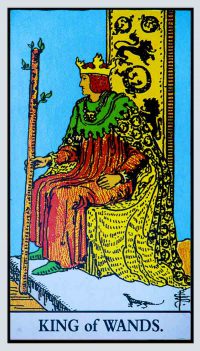
| Card Symbols | Symbol Meaning |
| King | The king symbolizes thoughts and feelings related to control, power, and security. The king’s actions are driven by his interests, particularly defensive interests, and he acts during times of tension. |
| Red Hair | His red hair symbolizes his fiery and impulsive nature. Orange symbolizes joy and happiness, sexuality, flexibility, balance between the physical and spiritual bodies, vitality, and creativity. It also symbolizes learning and experience. |
| Royal Throne | The gold in his throne symbolizes divinity. It also represents stability, control, and leadership. |
| Crown | Dominion, glory, perfection, continuity. |
| Lion | Leadership, courage, confidence, the ability to lead, balance between strength and physical power, responsibility, and vitality. |
| Wand | Authority, support, spiritual power, desires, initiative, a tool for realizing ideas. It symbolizes renewal and growth. |
| Green Cloak | Authority, power, grandeur. The green color symbolizes renewal, growth, hope, health, and youth. |
| Yellow Cloak | The yellow cloak symbolizes power, ego, self-image, and communication. |
| Orange Tunic | The orange tunic symbolizes abundance, fertility, love, creativity, and inspiration. Orange also expresses a tendency toward art and represents feminine intuition. |
| Lizard | The lizard symbolizes dreaming of the future and is considered to have supernatural powers. It represents the transition between worlds, extrasensory perception, and the connection between the material and spiritual. |
| Light Blue Background | Sky, spirituality, infinite possibilities, and eternity. |